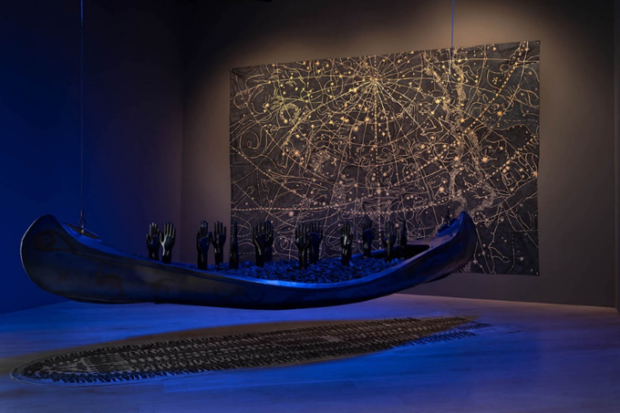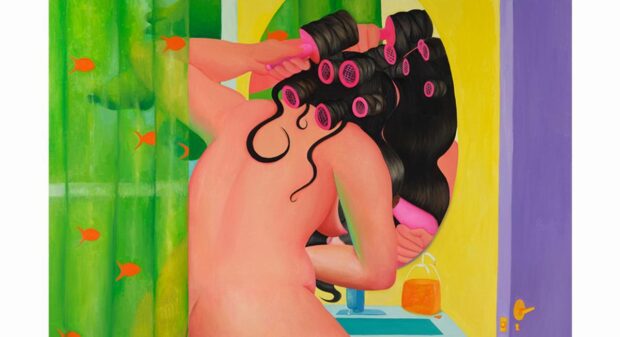In a gallery off to one side in the ongoing (through May 28, 2018) retrospective on the photography of Stephen Shore at the Museum of Modern Art is a row of iPads linked continuously to Shore’s ever-changing Instagram account. While Shore’s work has always strived to replicate quotidian experiences, it feels strange to scroll through the account while surrounded by his print-on-demand books of the same images, but also entirely natural. MoMA presents these digitally published and ‘hearted’ works as just another facet of the artist’s oeuvre, even including one of his old and cracked iPhones alongside his beloved Mick-a-Matic camera. While Shore’s use of Instagram feels like the 21st century version of the kinds of pictures he has been making through his entire career, other artists have taken up Instagram in ways that are challenging the art world at large.

Houston-based artist Phillip Kremer, whose work first inspired me to begin questioning how artists are using the now eight-year-old platform, has been pushing the boundary of what is accepted as art in the Instagram community since he began posting work in 2014. Kremer conceives of his portraits as Instagram posts; in fact, the artist’s entire process takes place within the rectangle of his smartphone. He selects faces via Google image searches, manipulates them through an iPhone application (the name of which the artist has refused to disclose), and posts them to his accounts (on both Instagram and Tumblr). Kremer also sells prints, books, cell phone cases, and more on his personal webpage. Aside from using his Instagram to promote sales of his work, Kremer’s grotesque portraits seem to oppose the kinds of images one expects to find on the platform: a space that has become inundated with beautifully staged images from food, travel, and lifestyle bloggers. The gallery-like experience promoted by Instagram through its sleek, all-white design compliments these kinds of images. Kremer’s portraits, decidedly not beautiful, harnesses the power of Instagram to elevate his works of art.

Instagram has censored Kremer’s account on multiple occasions, even deleting his first account entirely. According to Kremer, representatives from the app never disclosed why his account was removed and later temporarily suspended, although they did assure him that it did not depend on the artist’s representations of his favorite subject – President Donald Trump, distorted images of whom Kremer had to print via Walgreens self-service after several print-on-demand service companies refused to do so.[1] Since then, Kremer has continued to test the boundaries of Instagram’s fair use policies. In many of his works, he leaves in Getty Images tags on works posted to both the accounts that he owns (one of which is dedicated to lampooning President Donald Trump under the handle Dinild Trimp).

Kremer’s work doesn’t directly transgress any of the user guidelines of the application per say, it definitely toes the line, and Instagram maintains the right to disable an account at any time for any reason. The constant feeling that each of Kremer’s posts could be the last heightens the excitement of viewing his twisted faces, as if the experience of his Instagram is an illicit activity – perhaps exactly what he intends. Kremer’s work, for better or worse, has outlined what is ‘acceptable’ as art on social media. He has pushed these boundaries – using his following to protest Instagram to expand its, and by extension its consuming public’s, definition of art. Since his Instagram has become a viral sensation, Kremer had a solo-show of his work at the Hello Project Gallery in Houston, following a trend of many other artists who have found their way into the traditional gallery world via their social media accounts.[2]


While Kremer has used Instagram as a gallery space, where he could test and shape a more expansive definition of art, others have taken up Instagram as a medium in its own right. Amalia Ulman, a performance, installation, video, and web-based artist proved how Instagram could be used as a medium for performance through her four-month performance entitled Excellences & Perfections. The performance took place over Instagram and featured Ulman fashioning herself as “the Tumblr girl”, “the sugar-baby ghetto girl”, and “the girl next door.”[3] These transformations recall those of Cindy Sherman’s Untitled Film Stills. Sherman, who joined Instagram in 2016, used film stills in the 1970s to identify female tropes, just as Ulman’s Instagram performance identifies new 21st century female tropes. Similar to Kremer, Ulman’s performance explores social media’s power to create realities out of fictions. The social aspect of Instagram allows Ulman’s work to take on new facets, as the public could and did interact through the comments section with the artist during the performance. In 2016, Ulman experimented again with Instagram as a means of performance in a work entitled, Privilege, in which the artist created an exaggerated version of her own personality – even announcing and tracking a fake pregnancy. In that same year Excellences & Perfections was selected for Tate Modern’s Performing for the Camera exhibition (February 18 – June 12, 2016), for the show large-scale prints were made of Ulman’s selfies, and Ipads showed a feed of Ulman’s Instagram account.

In this case, a performance artist chooses Instagram as a means of creating art as it allows the artist to not only broadcast their work to a potentially global audience, but also acts as an immediate archive. If one wishes to experience Excellences & Perfections, all one would need to do is to scroll back in time to 2014. By capturing her performance via social media Ulman has made an ephemeral form of production permanent; as long as Instagram exists, so will her performances. Ulman’s practice raises many questions about how we should think about artists who take up this form: do sustained interactions from new followers on old performances constitute part of the work itself? What is the role of the prints if the performance itself can be accessed at any point in time for exhibition? Could anyone print one of her posts and sell it as an original work of art?
From these case studies it is clear that Instagram and social media at large is playing a major role in contemporary art. The art world has certainly taken notice of this phenomenon, as museum exhibitions of Shore and Ulman’s experiments on Instagram have presented the work in terms of already established practices: Shore’s images of the everyday and the photographic documentation of performance art. It is clear, even from this brief analysis, that the use of Instagram is moving past these pre-social media practices. The social aspect of Instagram and other platforms are changing the way we think about, look at, and participate in works of art. Artists are using social media, especially Instagram, as a proving ground for ideas and new definitions of art in that same way the white cube was used by previous generations.
[1] https://www.whiteliesmagazine.com/blog/2016/11/21/phillip-kremer
[2] https://www.artsy.net/show/hello-project-gallery-phillip-kremer-hells-belles
[3] http://www.vulture.com/2014/12/how-amalia-ulman-became-an-instagram-celebrity.html














Be First to Comment